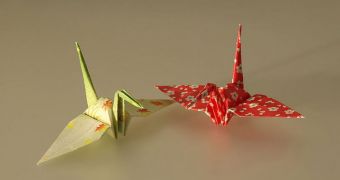Materials scientists at the Harvard University envision sets of paper robots that could be used during surgery, in situations where a more delicate touch is needed. They say that air could be used to fold the paper robots like origami. The resulting structures would be able to lift 120 times their own weight.
According to the team, all that is needed in order to create these machines is to encase paper sheets inside airtight silicone rubber. However, the trick is not to have both sides of the paper coated with the same type of silicone.
On one side of the paper, the silicon needs to be soft, translucent, and laden with very small air channels, through which a stream of air can circulate when the robot needs to be folded up. The other side of the paper can be covered with airtight silicone.
The basic operating principle behind this is very simple. As air is pumped through the permeable silicone coating on one side, it inflates the impermeable layer on the other side, forcing the paper to bend in particular ways.
“When the balloon part of the structure expands, it doesn't become round, as does a child's balloon. [Instead, it] adopts more complex shapes in response to the constraints imposed by the paper sheets,” Harvard researcher Ramses Martinez explains.
One of the most interesting aspects of such robots is that they flex in very much the same way as accordion bellows. This means that they can be stretched, bent, twisted, collapsed and so on, in a wide range of different shapes. Each configuration can be achieved through a variety of movements.
The controlling factor is the pattern in which air is made to circulate through the material. Rather than using artificial muscles, or other similar contraptions, the team decided to go for pneumatics and compression instead.
Through this approach, a small paper robot weighing just 8.2 grams could be used to lift a block of wood, for example, weighing as much as 1 kilogram (2.2 pounds), Innovation News Daily reports.
“The methods we developed are astonishingly simple for the complex motions that they generate. Once we understood the materials to use, the best procedures for fabrication and the kinds of designs that worked best,” Martinez explains.
In addition to medical applications, the new technology could be used on robots engaged in search and rescue operations, as well as in car shops. “We hope these structures can be developed into assistants for humans,” Martinez concludes.

 14 DAY TRIAL //
14 DAY TRIAL //